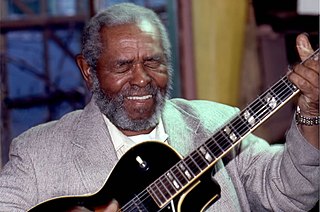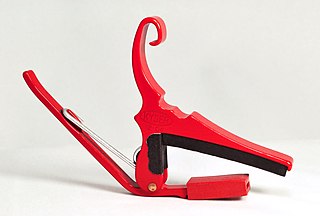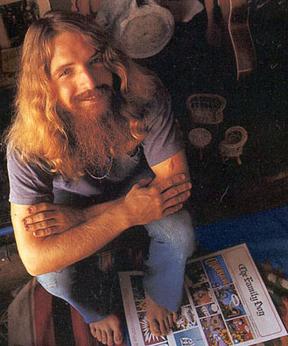Related Research Articles
The banjo is a stringed instrument with a thin membrane stretched over a frame or cavity to form a resonator. The membrane is typically circular, in modern forms usually made of plastic, originally of animal skin. Early forms of the instrument were fashioned by African Americans and had African antecedents. In the 19th century, interest in the instrument was spread across the United States and United Kingdom by traveling shows of the 19th century minstrel show fad, followed by mass-production and mail-order sales, including instruction method books. The inexpensive or home-made banjo remained part of rural folk culture, but 5-string and 4-string banjos also became popular for home parlour music entertainment, college music clubs, and early 20th century jazz bands. By the early 21st century, the banjo was most frequently associated with folk, bluegrass and country music, but was also used in some rock, pop and even hip-hop music. Among rock bands, the Eagles, Led Zeppelin, and the Grateful Dead have used the five-string banjo in some of their songs.

Walter Brown "Brownie" McGhee was an American folk music and Piedmont blues singer and guitarist, best known for his collaboration with the harmonica player Sonny Terry.

James Roger McGuinn is an American musician. He is best known for being the frontman and leader of the Byrds. He was inducted into the Rock and Roll Hall of Fame for his work with the Byrds. As a solo artist he has released 10 albums and collaborated with, among others, Bob Dylan, Tom Petty and Chris Hillman. The 12-string Rickenbacker guitar is his signature instrument.

A capo is a device a musician uses on the neck of a stringed instrument to transpose and shorten the playable length of the strings—hence raising the pitch. It is a common tool for players of guitars, mandolins, mandolas, banjos, ukuleles and bouzoukis. The word derives from the Italian capotasto, which means the nut of a stringed instrument. The earliest known use of capotasto is by Giovanni Battista Doni who, in his Annotazioni of 1640, uses it to describe the nut of a viola da gamba. The first patented capo was designed by James Ashborn of Wolcottville, Connecticut year 1850.

Richard Alden "Rick" Griffin was an American artist and one of the leading designers of psychedelic posters in the 1960s. As a contributor to the underground comix movement, his work appeared regularly in Zap Comix. Griffin was closely identified with the Grateful Dead, designing some of their best-known posters and album covers such as Aoxomoxoa. His work within the surfing subculture included both film posters and his comic strip, Murphy.
The Psychedelic era was the time of social, musical and artistic change influenced by psychedelic drugs, occurring from the mid-1960s to mid-1970s. The era was defined by the proliferation of LSD and its following influence in the development of psychedelic music and psychedelic film in the Western world.

Victor Moscoso is a Spanish–American artist best known for producing psychedelic rock posters, advertisements, and underground comix in San Francisco during the 1960s and 1970s. He was the first of the rock poster artists of the 1960s era with formal academic training and experience. He was the first of the rock poster artists to use photographic collage in many of his posters.

Shubb is a company that specialises in producing capos for all kinds of stringed instruments. The company was formed in 1974 by banjoists Rick Shubb and Dave Coontz. Shubb capos remain a top-selling capo forty years after their invention. Shubb wanted to create a capo that would not make his instrument go out of tune, which has resulted in ongoing efforts to refine his invention. Since 2016 at least 80% of Shubb's Capos are manufactured in China.
Alexander "Sandy" Bull was an American folk musician and composer. Bull was an accomplished player of many stringed instruments, including guitar, pedal steel guitar, banjo, and oud. His early work blends non-western instruments with 1960s folk revival, and has been cited as important in the development of psychedelic music.

We Five was a 1960s folk rock musical group based in San Francisco, California. Their best-known hit was their 1965 remake of Ian & Sylvia's "You Were on My Mind", which reached No. 1 on the Cashbox chart, #3 on the Billboard Hot 100, and #1 on the Adult Contemporary chart. The original group split after recording their second album in 1967, but a re-formed band produced three more albums between 1968 and 1977.
Jesse Fuller was an American one-man band musician, best known for his song "San Francisco Bay Blues".
John Dopyera was a Slovak-American inventor and entrepreneur, and a maker of stringed instruments. His inventions include the resonator guitar and important contributions in the early development of the electric guitar.
Stanley George Miller, better known as Mouse or Stanley Mouse, is an American artist who is notable for his 1960s psychedelic rock concert poster designs and album covers for the Grateful Dead, Journey, and other bands.
Michael DeTemple is an American musician and luthier known for his handmade solid-body guitars. Born and raised in Los Angeles, California, DeTemple began repairing and maintaining a wide range of stringed instruments at the age of thirteen. Early on, he became acquainted with renowned guitarist Ernie Ball, who retained his services by paying with old guitars.
Jazz guitarists are guitarists who play jazz using an approach to chords, melodies, and improvised solo lines which is called jazz guitar playing. The guitar has fulfilled the roles of accompanist and soloist in small and large ensembles and also as an unaccompanied solo instrument.

A partial capo is a type of a capo designed to capo only some of the strings of an instrument, as opposed to a standard capo which affects all strings.
John Pearse was a British guitarist, folk singer and music educator, who came to prominence in the 1960s presenting the popular BBC2 television guitar tuition series, Hold Down a Chord.

Limited Edition is the seventh studio album by American rock musician Roger McGuinn. It was issued in April 2004 as an exclusive Internet release. The album marked McGuinn's return to his signature instrument, the Rickenbacker 12-string electric guitar, after several projects focusing on folk and other traditional musical styles. The opening song is a cover of the Beatles' 1965 track "If I Needed Someone", which McGuinn recorded as a tribute to George Harrison. The album's other tracks include seven songs written by McGuinn and his wife and longtime collaborator, Camilla McGuinn, and traditional songs arranged by the couple.

Chuck Sperry is an American artist best known for his screen prints on paper and oak panel, his limited-edition rock posters for bands such as Widespread Panic and Pearl Jam, and his political protest art. Since 1985, Sperry's iconography has ranged from astronauts walking on the surface of the moon to portraits of performers as varied as Willie Nelson, Bob Dylan, and Chrissie Hynde. Beginning in 2010, many of Sperry's prints have featured images of female muses from Greek mythology.
References
- ↑ CNNmoney: Business 2.0 magazine, March 15, 2007,
- ↑ Sterner Capo Museum
- ↑ U.S. Patent Office
- ↑ Lambiek's Comiclopedia
- ↑ Fretboard Journal magazine, Feb 2007 issue
- ↑ Paul D. Grushkin, The Art of Rock: Posters from Presley to Punk. Abbeville Press; New Ed edition (July 1987)
- ↑ Last Gasp Publishing